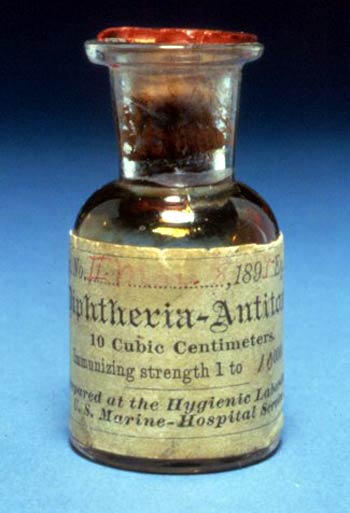Diphtheria historical perspective: Difference between revisions
No edit summary |
Tarek Nafee (talk | contribs) No edit summary |
||
| Line 2: | Line 2: | ||
{{Diphtheria}} | {{Diphtheria}} | ||
{{CMG}} | {{CMG}} | ||
==Overview== | |||
==Historical Perspective== | ==Historical Perspective== | ||
[[Image:Antitoxin diphtheria.jpg|thumb|left|One of the first bottles of diphtheria antitoxin (1895), produced by the United States Hygienic Laboratory (now the [[National Institutes of Health]]).]] | [[Image:Antitoxin diphtheria.jpg|thumb|left|One of the first bottles of diphtheria antitoxin (1895), produced by the United States Hygienic Laboratory (now the [[National Institutes of Health]]).]] | ||
| Line 16: | Line 17: | ||
{{Reflist|2}} | {{Reflist|2}} | ||
[[Category:Infectious disease]] | [[Category:Infectious disease]] | ||
{{WikiDoc Help Menu}} | {{WikiDoc Help Menu}} | ||
{{WikiDoc Sources}} | {{WikiDoc Sources}} | ||
Revision as of 18:54, 7 October 2016
|
Diphtheria Microchapters |
|
Diagnosis |
|---|
|
Treatment |
|
Case Studies |
|
Diphtheria historical perspective On the Web |
|
American Roentgen Ray Society Images of Diphtheria historical perspective |
|
Risk calculators and risk factors for Diphtheria historical perspective |
Editor-In-Chief: C. Michael Gibson, M.S., M.D. [1]
Overview
Historical Perspective

Diphtheria was named in 1826 by French physician Pierre Bretonneau. The name alludes to the leathery, sheath-like membrane that grows on thetonsils, throat, and in the nose. The pronunciation Template:IPA was originally considered incorrect, but has become the most common way of saying the word, and is accepted as a correct form. While many writers today use the spelling "diptheria" which fits the modern pronunciation, this spelling is rarely found in dictionaries.
Diphtheria was once a dreaded disease, with frequent large-scale outbreaks. A diphtheria epidemic in the New England colonies between 1735 and 1740 was said to have killed as many as 80% of the children under 10 years of age in some towns.[1]
In the 1920s there were an estimated 100,000 to 200,000 cases of diphtheria per year in the United States, causing 13,000 to 15,000 deaths. Children represented a large majority of these cases and fatalities. One of the most famous outbreaks of diphtheria was in Nome, Alaska; the trip made to get the antitoxin is now celebrated by the Iditarod Trail Sled Dog Race.
Diphtheria was also prevalent in the British royal family during the late 19th century. Famous cases included a daughter and granddaughter of Britain's Queen Victoria. Princess Alice of Hesse (second daughter of Queen Victoria) died of diphtheria after she contracted it from her children in December of 1878 while nursing them. One of Princess Alice's own daughters, Princess May, also died of diphtheria in November of 1878.[2]
One of the first effective treatments for diphtheria was discovered in the 1880s by U.S. physician Joseph O'Dwyer (1841-1898). O'Dwyer developedtubes that were inserted into the throat, and prevented victims from suffocating due to the membrane sheath that grows over and obstructs airways. In the 1890s, the German physician Emil von Behring developed an antitoxin that did not kill the bacteria, but neutralized the toxic poisons that the bacteria releases into the body. von Behring was awarded the first Nobel Prize in Medicine for his role in the discovery, and development of a serum therapy for diphtheria. (Americans William H. Park and Anna Wessels Williams; and Pasteur Institute scientists Emile Roux and Auguste Chaillou also independently developed diphtheria antitoxin in the 1890s.) The first successful vaccine for diphtheria was developed in 1923. However, antibiotics against diphtheria were not available until the discovery and development of sulfa drugs following World War II.
References
- ↑ Caulfield, Ernest. (1949) "A True History of the Terrible Epidemic Vulgarly Called the Throat Distemper, Which Occurred in His Majesty's New England Colonies between the Years 1735 and 1740." The William and Mary Quarterly, 3rd Ser., Vol 6, No 2. p. 338. See Also: Shulman, Stanford (2004) The History of Pediatric Infectious Diseases (Html by Google) Pediatric Research. Vol. 55, No. 1
- ↑ Baker, Raegan Princess Alice of Hesse and by Rhine Alexander Palace Time Machine.